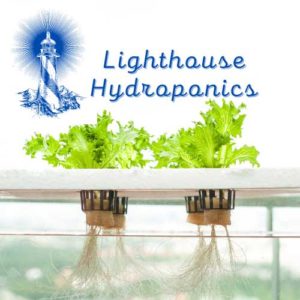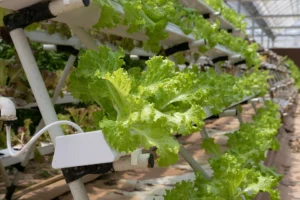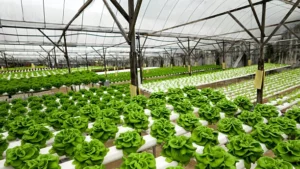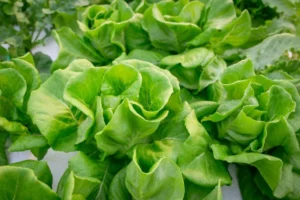There was a time when it seemed hydroponics feed the world and would become the next big thing. In the late 1970s, though, the U.S. produced a net deficit of agricultural products even as consumer interest in sustainable farming practices grew. The decline of hydroponics can be attributed to several factors: for one, environmental concerns about large-scale nutrient runoff from hydroponic gardens. There is also the argument that soil-based agriculture is more sustainable because it nourishes the topsoil with organic matter, whereas hydroponics results in soil depletion. And of course, there are concerns about genetically modified organisms (GMOs) used in some hydroponic farms.
Nevertheless, advocates of hydroponics maintain that the technology has many advantages, from increased food production to reduced land requirements. In addition, they say hydroponics can actually improve soil quality by recycling waste nutrients and other biological materials.
Here are just some of the benefits of hydroponic growing methods:
· Food Production – Some hydroponics operations claim yields up to 200 times greater than soil farming. In one study, hydroponic lettuce yielded almost 12 tons per acre versus about a half-ton from the same size area of soil-grown plants 1.
· Decreased Energy Usage – The amount of energy used for food production is enormous. Hydroponics may require less land, water, fertilizer, and pesticides to produce the same yield as soil farming. Thus, using hydroponics can result in a smaller carbon footprint compared with conventional food production.
· Reduced Land Requirements – In times of land shortage or migration to urban areas, hydroponic farming may reduce the need for cropland. Properly maintained hydroponic systems require very little soil, so they can be located in urban areas where fresh produce is not readily available.
· Natural Habitat Preservation – Hydroponics reduces or eliminates the need for deforestation because it does not require farmland. Again, this is beneficial for land availability and helps to preserve natural habitats.
· Reduced Nutrient Pollution – Soil farming can cause environmental problems, such as excess nutrient runoff. This occurs when the fertilizer applied to farm fields drains off into waterways and causes algae blooms or eutrophication. Hydroponics uses liquid solutions containing only the necessary elements required for plant growth, so there is little chance of nutrients leaching off the farm.
· Higher Productivity – Hydroponics can produce higher vegetable yields than soil farming, with less water usage because the roots are always in the nutrient-rich solution. Plants grown hydroponically require minimal weeding and pest control, so farmers spend less time monitoring their crops 2.
Can hydroponics solve world hunger?
Hydroponics may solve world hunger, but not by itself. While it will not feed the world on its own, sooner hydroponics feed the world and maybe a useful tool that can address food security issues around the world.
Will hydroponics change the agricultural world?
Hydroponics is changing the agricultural industry because it has many advantages over soil farming. In addition to increased productivity and decreased land usage, hydroponics
How does hydroponics help the world?
Aquaponics, hydroponics, and aeroponic farming systems are all examples of modern-day farming that can be used in third-world countries to help feed populations that do not have the space or resources for traditional agricultural systems. Hydroponics is one example of an efficient method of food production that takes up less than it gives back.
Efficacy of Growth – Each type has optimization parameters to promote maximum growth rates. However, some require more energy to achieve these growth rates than others.
Is hydroponics the future?
It is predicted that 50% of farming will become hydroponic in the next 10 years. This is only the beginning to revolutionize farming.
The world is becoming more industrialized, and it’s getting harder to feed the people of the world with conventional methods. Not everyone lives on a farm, but almost everybody eats food that comes from somewhere else.
Unfortunately for the world, most of these conventional sources are not sustainable. Hydroponics provides the world with an answer to this problem. It has been proven that hydroponics uses 90% less water than conventional methods, and grows 2 times more crops per year. This is great for the world because it’s starting to face problems with the lack of clean drinking water.
How does hydroponics increase food production?
With over 7 billion mouths to feed, the Earth is in serious need of new food production methods. Without drastic changes to our current agricultural system, there won’t be enough arable land to grow all the food necessary for the population projected by the year 2050.
One solution to this problem? Hydroponics! This method uses 90% less water than soil-based farming, doesn’t use fertilizers or pesticides, and can be produced anywhere. It’s no wonder that hydroponics is the fastest-growing method of food production on Earth!
How is hydroponics being used to address food security issues around the world?
Hydroponics is becoming an increasingly popular method of food production, most notably for growing vegetables. This alternative to traditional agriculture uses less water, has reduced costs, and can produce four times as much produce per acre as conventional farming. Furthermore, hydroponic farms are able to grow year-round regardless of weather conditions.








